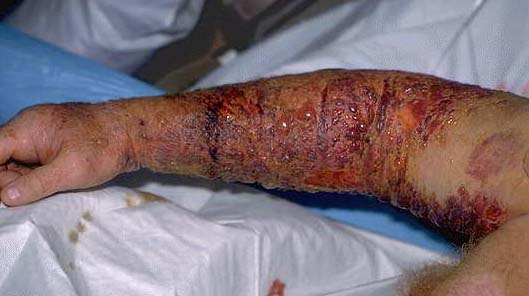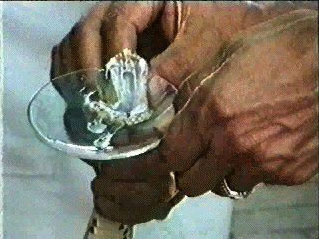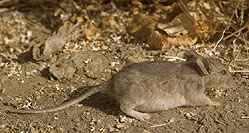
Antivenin
Snakebites can be extremely dangerous and serious. The venom is made up of many enzymes which help break down tissue. Antivenin or antivenin is needed to stop this process. The picture below is of a man who has been bitten on the arm by a rattlesnake. Image taken for http:\\www\venomous.com.

First, the venom is "milked" from the snake. Large quantities of snake venom are needed, hence snake farms are need to create enough antivenin for treatment of snake bite victims.

Snake venom being milked from a cobra, image taken from http://www.engin.umich.edu
Then, it is diluted and injected into a horse or goat. As the animal builds up immunity to the venom the dosage is increased and the animal creates blood rich in antibodies.
Antibodies are blood proteins created to fight antigens. These antibodies collect in the serum, which is eventually separated from the dark red cells, by centrifugation. After the serum has been purified, it is ready to be injected at a moment's notice into a snakebite victim.
Antivenin acts to neutralise the poisonous venom of a snake and causes the venom to be released from the receptor site. Thus, the receptor sites that were previously blocked by venom are now free to interact with the acetylcholine molecules and normal respiration resumes. The spent antivenin and the neutralised venom are then excreted from the body. Venom composition (and its corresponding toxicity) can vary among snakes of the same species and even from the same litter. It can also vary for an individual snakes during their lifetimes. All of this makes each snake bite truly unique. In order to ensure correct treatment antibodies specific to each form of snake venom must be developed. The interaction of the venom and the antivenin with the receptor sites can be modelled as a reaction engineering catalysis problem. Examples of the reactions are given below.
Careful execution of the injection of the antivenin is necessary to avoid any complications that may result from improper treatment. If the amount of antivenin is not sufficient to neutralise all of the venom a portion of the receptor sites will remain blocked and the person would require the use of artificial respiration machines and electrical impulses to have complete respiration. Due to the size of the antivenin molecule, if given in great excess, it may act to shield the receptor site from interaction with the acetylcholine molecule. Thus, the victim would develop symptoms similar to that of being bitten by a snake. Unlike venom; however, the antivenin will eventually be released from the body. The rate of release is very slow, and although there are no proven cases of excess antivenin causing death, severe problems such as paralysis have occurred.
|
Adsorption of venom onto site: |
||
|
|
|
|
|
|
|
|
|
Adsorption of antivenin onto site: |
||
|
|
|
|
|
|
|
|
|
Reaction of venom with antivenin on site: |
||
|
|
|
|
|
|
|
|
|
Reaction of antivenin with venom on site: |
||
|
|
|
|
|
|
|
|
|
Reaction of venom and antivenin in blood: |
||
|
|
|
|
|
Removal of product and reactants from system: |
||
|
|
|
|
|
|
|
|
|
|
|
|
|
where: V = venom |
Certain warm-blooded animals have a natural resistance to snake venom. Dr. Pérez and his students were among the first to show that certain warm-blooded animals have a natural resistance to snake venoms. They have isolated and identified antihaemorrhagins in four warm-blooded animals (Gray Woodrat, Neotoma micropus; North American Opossum, Didelphis virginiana; Mexican Ground Squirrel, Spermophilus mexicanus; and Hispid Cotton Rat, Sigmodon hispidus). His lab is interested in the mechanism by which naturally occurring antihaemorrhagins neutralise haemorrhagic activity in snake venoms. The antihaemorrhagins isolated are not antibodies and do not form precipitates. The antihaemorrhagins have molecular weights which are less than antibodies. However, the woodrat has natural inhibitors that allow it to have a natural resistance to venom's and may allow them to escape death. Woodrats have 121 times more resistance than regular lab mice according to antihaemorrhagic assays.

Picture of a wood rat which has a resistance to snake venom 120 times greater than that of a normal mouse to the same snake venom. Image taken form http://www.sdnhm.org











